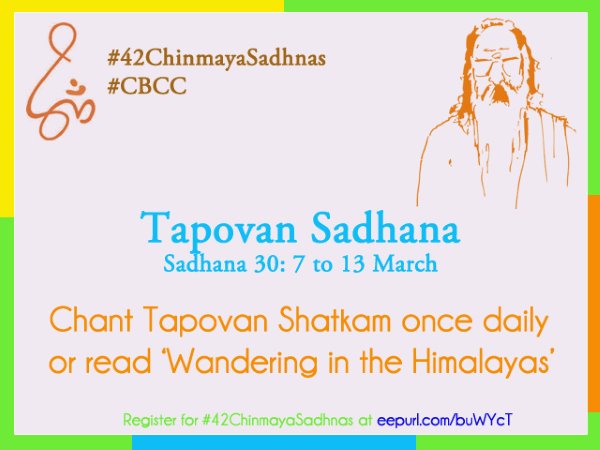Sadhana for Week 30
Speech Level: Tapovan Sadhana
Chant Tapovan Shatkam once daily. Read Wandering in the Himalayas.

Quote:
Swami Tapovanam was an institution uncaused,
And He, too, caused no cause,
He came from nowhere, existed everywhere,
And ultimately went to be everywhere.
All I am,
All I have done,
Is only because of my teacher,
Swami Tapovan Maharaj.
- Swami Chinmayananda
Anecdote:
A Brahmatman is one whose Atman has become one with Brahman;
One who has found his identity with the Self everywhere.
He is called Brahmavid, the knower of Brahman.
- Swami Chinmayananda
Swami Tapovanam was such a pure soul that he saw God in everything. Poojya Gurudev would accompany Swami Tapovanam on their return journey from Gangotri to uttarkashi during the winter months. Along the way he would stop and point out the majestic scenery.
“Look at those clouds, Chinmaya. So beautiful is all of nature. How can anyone not believe the grace and beauty of the Lord when they see his form manifested in this wonderful world of nature”. Try as he might, Chinmaya could not quite see what was that Swami Tapovanam was seeing in those clouds.
Poojya Gurudev later wrote of those blissful days with his teacher in his introduction to Wandering in the Himalayas by Swami Tapovanam:
When we used to move back and forth from Uttarkashi to Gangotri, Swamiji would often stop abruptly in the trail, alert and thrilled, tense and silent. I watched him: now lost in wonder at the snow peaks, now aghast at the thundering laughter of the Ganga in her panting speed; even a long-tailed bird fluttering across the path was sufficient to tickle Swamiji into a vivid rapture. At these times he would stand still, bathed in a vivid glow of joy, whispering silently his homage to the Creator.
Who was SwamiTapovan Maharaj?
How to explain to you all, that what I saw in Him was what I saw in the Upanishads and in the Bhagavad Gita. The work of spreading the Gita and the Upanishads was to unveil Him and His glory, His vibhuti - 'Tapovan Mahima', in the hearts of all.
- Swami Chinmayananda
Swami Tapovan Maharaj is one of the most renowned saints in the Himalayas and was called as Himavat Vibhooti. He was a contemporary of Swami Sivananda Maharaj and was the Guru of Poojya Gurudev. The Perfect Seer experiences his own Self in everything and roams around the world experiencing the divine Presence everywhere at all times. To one who is thus living inwardly this constant God-experience, to him every incident - everything and being – is but a fugitive note from the Infinite Song. Swami Tapovan Maharaj was a reveler of this type as he lived in the valleys of the Himalayas.
Swami Tapovan was born in 1889 in Palakkad, Kerala to Kunchamma (mother) who belonged to an ancient aristocratic Nair family and Achutan Nair (father), who belonged to Kotuvayur in Kerala. From his childhood he exhibited signs of spiritual life – he delighted in listening to Puranic stories, worshipping idols which he made with his own hands, visiting temples, talking and spending time with men learned in the scriptures and mahatmas. He would spend hours reading and studying any book that was about religion and spiritual life. Although he was a brilliant student Chippukutty (as was Swamiji Tapovan’s name prior to taking sanyasi) decided to give up going to school to which his father objected, to which he replied, that he was only giving up school not his studies! Under competent teachers he studied poems, dramas, grammar and logic. Simultaneously he spent part of his time studying and understanding Vedanta. He read all available religious texts in Malayalam, Tamil, English and Sanskrit.
When he was barely eighteen he published his first poem and after the death of his father at the age of twenty he wrote his next poem “Vishu Yamakam” which won him accolades from the literary community. Already living a sanyasi’s life (he woke up very early in the morning, had a bath and devoted all his time till 10 am to dhyaan, bhajans, studies and other spiritual practices) he continued to perform all his obligatory duties towards his brother and the family business. Once his brother became a lawyer he was finally able to fulfil his long cherished desire to live like a mendicant. In August - September 1923 he left his hometown never to return to the plains again.
He lived a strict solitary lifestyle in the Himalayan region along the holy Ganga - Gangotri, Uttarkashi and Rishikesh.
Swami Sivananda called him ‘Himavat Vibhuti,’ meaning “the glory of the Himalayas”; and in the world of sages and ascetics, he is acknowledged as one of the four great enlightened masters of Vedanta who lived in the Himalayas during the time, along with Swami Vishnudevananda, Brahmaprakasa Udasina, and Devagiri Swami.
That Truth, which Swami Tapovanam realized and indicated in all his teachings, is beyond words, as much as he himself was. Swami Chinmayananda said of his Guru, “He was a God without temple, a Veda without language.”
To know more about Swami Tapovanam, read his autobiography – Ishwar Darshan.
Why chant Tapovan Shatkam?
Tapovan Shatkam
Swami Tapovanam was a Mahatma, a true Vedantin of deep devotion and attained the highest spiritual realization. He chose to remain in his humble, mud-plastered one-room kutia with a small verandah at Uttarkashi. He lived away from the worldly, materialistic life, reveling in His own Self. He despised all ostentations, physical and mental. He recommended study, reflection and attempts at direct experience.
Tapovan Maharaj was the Guru of Poojya Gurudev. Tapovan Shatakam is a prayerful hymn, a salutation to this great master composed in the vocabulary of the Upanishads which invokes the Supreme Self and identifies that Self Divine with Swami Tapovanam.
Benefits:
To be able to realise that the infinite substratum for the entire universe is the Supreme Self we must learn to lift our minds to meet Him where He is in our own heart. By chanting Tapovan Shatakam we remind ourselves of our real purpose of life, of the qualities of Tapovan Maharaj, of the pointers to the Truth for they are the same.
We chant to invoke the grace of Swami Tapovanam, to seek his blessings of so that we too may become the knowers of Brahman.
I prostrate to that Guru whose two lotus feet help to remove all the miseries arising out of the pairs of opposites and who helps us to cross over the ocean of transmigration
- Guru Gita, 1.27
Why read Wandering in the Himalayas?
Swami Tapovan authored a number of books in his beloved mother tongue, Malayalam – these include translations and commentaries on the Upanishads and two books on his travels through the Himalayas: "Wanderings in the Himalayas" (Himagiri Viharam) and "Kailasa Yatra". How to behold the Divine in and through this creation? What is the journey of life? What is the significance of various pilgrimage spots like Char Dham etc. is beautifully described in this book. Reading this book will literally take us on a journey to the beautiful destinations in the Himalayas.
Extract of the Foreword by Swami Chinmayananda
Wandering in the Himalayas consists of poetic descriptions of places of importance in the Himalayas, sacred in their cultural lore and in the traditional faith of the Hindus. They are the many captured pictures framed by Shree Swami Tapovanji’s mighty pen….
In the following pages you can read how the man of Divine Vision beholds Truth everywhere-be it in lifeless trees or among singing birds; in the cruel roar of animals, in the silent womb of the jungle, or in the bright expanse of the summer sky; in the rise of the sun; in the crescent moon; or in the tiny stars; in the whispering darkness, in dancing peacocks, in jumping monkeys, or in tender cows; be it at the sight of some poor villagers of Himalayan hamlets sitting and smoking their native pipes, or on beholding the vigorous hill-maidens working in the fields.
Benefits:
The sincerity of the writer lends a secret charm to his pen and conveys the same feelings to the reader. The reader of this book who has in his heart reverence and devotion to Nature need not thereafter read Scriptures or even go through the sorrows of tapas to enjoy the Vision of the Infinite that plays in and through every form.
Who said that the Lord is formless? They are blind - blind to his Presence. They are deaf - deaf to His Song which throbs everywhere. Those who read Wandering in the Himalayas will develop in themselves the true vision to see the Unseen and to hear the Unheard. Wandering in the Himalayas can open both your eyes and years. Vedanta does its miracle in every in every student; makes the blind see and the deaf hear.
- Swami Chinmayananda
How to?
1. Download Tapovan Shatkam from here if you need: http://swatmananda.podomatic.com/entry/2016-03-08T06_51_33-08_00
2. Every morning after a bath chant Tapovan Shatkam with faith and pure devotion.
3. Close your eyes after the chant and sit quietly for 10 minutes
4. Prostrate mentally to the image of Tapovan Maharaj in your mind.
5. Later in the day or anytime when you will not be disturbed read about 8 to 10 pages of Wandering in the Himalayas daily.
6. Think about what you have read. Go over it in your mind and contemplate on the essence.
Beginners and Advanced:
Beginners:
1. Read Wandering in the Himalayas and do as advised above.
This is a very important step. To be able to appreciate anything one has to first know about it. Through this book the reader will know who Tapovan Maharaj was, his thoughts, his persona, his detachment, his abundant love for nature, his devotion, his purity, his austerity. He lived in a different plane altogether, in the world but never of the world.
To be able to read (genuinely read, not like a novel) this book is a blessing by itself. As PoojyaGurudev has stated just reading and understanding the nuances of this book is enough. If one is able to grasp all that has been described there is no need for any scriptural study, the very essence of Vedanta has been beautifully narrated through personal experiences.
2. Keep this book. Do not discard it or give it away after going through it once.
3. Read it again after some months. You will discover more hidden gems. In fact every time you re-read it more will be revealed. That is because each of us is evolving every day. As we progress we are able to appreciate the subtle aspects which in our earlier reading were either missed out or not completely understood.
4. If you have benefited from it, gift it to someone who shares similar ideologies or wants to understand the vision and meaning of life. It may change their life.
Advanced seeker:
1. Memorize Tapovan Shatkam. close your eyes and visualize the form of Swami Tapovan Maharaj in front of you while chanting.
2. If you already know about Swami Tapovan Maharaj and have read Wandering in the Himalayas, read Ishwara Darshan and other books by Swami Tapovan Maharaj. It is one of the simplest, easiest and most engaging ways to learn, understand and live Vedanta.
Our search for Truth is not a sign of cowardice, laziness or lack of intelligence.
On the other hand, it is the mark of bravery, enthusiasm and intelligence.
- Swami Tapavan Maharaj
.jpg)
UNTO HIM OUR BEST


